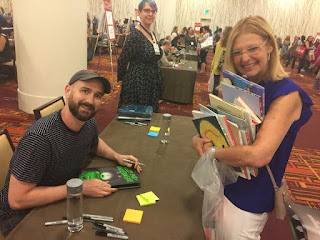 |
| Team Blog #LA17SCBWI: from left, Sona Charaipotra, Jaime Temairik, Lee Wind, Jolie Stekly, and Susie Ghahremani. |
And here are the dates for the 19th Annual Winter Conference in New York City: February 2-4, 2018.
With full-day intensives for both writers and illustrators
Juried Portfolio Showcase with grand prize
Network with top editors, agents, and publishers
Be in the center of the children's publishing industry
Workshops, Keynotes, networking, and much more!
Online conference registration will be posted in October at scbwi.org
And for the 47th Annual Summer Conference in Los Angeles: August 3-6, 2018.
With over 75 workshops and 15 keynote speakers
Monday post-conference intensives
Special hands-on workshops for illustrators, Craft intensives for published, self-published, and pre-published authors
Individual manuscript or portfolio critiques
Juried portfolio showcase with grand prize and mentorship opportunities
Online conference registration will be posted in March 2018 at scbwi.org
With full-day intensives for both writers and illustrators
Juried Portfolio Showcase with grand prize
Network with top editors, agents, and publishers
Be in the center of the children's publishing industry
Workshops, Keynotes, networking, and much more!
Online conference registration will be posted in October at scbwi.org
And for the 47th Annual Summer Conference in Los Angeles: August 3-6, 2018.
With over 75 workshops and 15 keynote speakers
Monday post-conference intensives
Special hands-on workshops for illustrators, Craft intensives for published, self-published, and pre-published authors
Individual manuscript or portfolio critiques
Juried portfolio showcase with grand prize and mentorship opportunities
Online conference registration will be posted in March 2018 at scbwi.org

















































